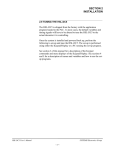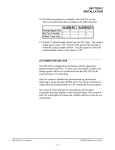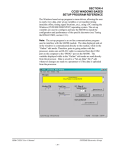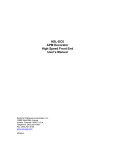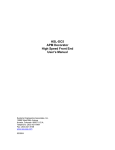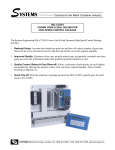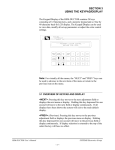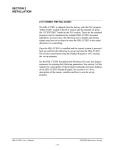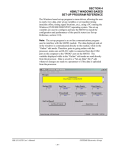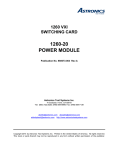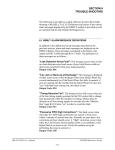Download HSM-DC8 RAGSDALE (APM) DECORATOR HIGH SPEED LOGIC
Transcript
HSM-DC8
RAGSDALE (APM) DECORATOR
HIGH SPEED LOGIC MODULE
USER’S MANUAL
Systems Engineering Associates, Inc.
14989 West 69th Avenue
Arvada, Colorado 80007 USA
Telephone: (303) 421-0484
Fax: (303) 421-8108
www.sea-seg.com
01/2004
HSM-DC8
RAGSDALE (APM) DECORATOR
HIGH SPEED LOGIC MODULE
USER’S MANUAL
Copyright © 2001 Systems Engineering Associates, Inc.
All Rights Reserved!
WARNING
To ensure that the equipment described by this User Manual, as well as the equipment
connected to and used with it, operates satisfactorily and safely, all applicable local and national
codes that apply to installing and operating the equipment must be followed. This includes the
National Electrical Code in the USA and other applicable legislation, regulations, and codes in
practice elsewhere. Since codes can vary geographically and can change with time, it is the
user’s responsibility to determine which standards and codes apply, and to comply with them.
FAILURE TO COMPLY WITH APPLICABLE CODES AND STANDARDS CAN RESULT IN
DAMAGE TO EQUIPMENT AND/OR SERIOUS INJURY TO PERSONNEL.
Persons supervising and performing installation or maintenance must be suitably qualified and
competent in these duties, and should carefully study the User Manual and any other manuals
referred to by it prior to installation and/or operation of the equipment.
The manufacturer accepts no liability for any consequences resulting from inappropriate,
negligent or incorrect installation, operation, or adjustment of the equipment.
The contents of the User Manual are believed to be correct at the time of printing; however, no
responsibility is assumed for inaccuracies. In the interests of a commitment to a policy of
continuous development and improvement, the manufacturer reserves the right to change the
specification of the product or it’s performance or the contents of the User Manual without notice.
Copyright © 2001 Systems Engineering Associates, Inc.
All rights reserved!
CONTENTS
1. General Description
1
1.1
1.2
1.3
1.4
1.5
1.6
1
2
3
3
4
5
Features
Functional Description
Odd and Even trip Cam Control
Bad Can and Select-A-Can Pin Chain Blow-off
Alarm Detection
Data Collection
2. Installation
7
2.1
What’s Included
2.2
Power Required
2.3
Mounting the HSM-DC8
2.4
Wiring the HSM-DC8
2.5
Mounting the HSL-QCSTA (optional)
2.6
Mounting the RSV34-MS1 Resolver (if required)
2.7
Mounting the Mandrel #1 Mark Sensor
2.8
HSM-DC8 Software Installation
2.9
SYSdev Program Development Software Installation
2.10
HSM-DC8 Application Program Installation
2.11
Modify Existing PLC Program
2.12
Tuning the HSM-DC8
2.12.1
Default Set-Up Variables
2.12.2
Set Machine Zero
2.12.3
Verify Location of Can/No Can Sensor
2.12.4
Set Pin Chain Blow-off Timing
2.12.5
Set # of Pins to Pin Chain Blow-off Port
2.12.6
Set # of Cans to Blow-off at Restart
2.12.7
Set QC Blow-off Shift Offset
2.12.8
Set Spindle Trip Shift Offset
2.12.9
Set Canfeed Enable Speed
2.12.10 Set O’Varnish Roll Speed Calibrate
2.13
HSM-DC8 Module Replacement
7
7
8
9
10
10
11
11
12
13
14
16
16
17
17
18
18
19
19
20
20
21
21
3. Using the HSM-DC8 Keypad / Display
23
3.1
3.2
3.3
3.4
3.5
23
24
24
25
26
27
28
30
32
Default Screen
“Trips per Spindle” Key
“Current Shift” Key
“Last Shift” Key
“Set-Up” Key
3.5.1 Speed Parameters
3.5.2 Set Pin Chain/QC Blow-off Parameters
3.5.3 Set Machine timing (set-points, etc.)
3.5.4 Zero Resolver (Set Resolver Offset)
3.6 “QC Blow-off” Key
3.7
Set Keypad/Display “Set-Up” Key Passcode
HSM-DC8 User’s Manual
33
33
SYSTEMS Electronics Group
-i-
CONTENTS
4. “HSMDC8” Set-up Program Reference
35
4.1
Set Speed Parameters
4.1.1 Canfeed Enable - Low Speed
4.1.2 Canfeed Enable - High Speed
4.1.3 O’Varnish Roll Speed Calibrate
36
36
36
37
4.2
Set Pin Chain/QC Blow-off Parameters
4.2.1 Set Bad Can (Pin Chain) Blow-off Response Times
4.2.2 Set Number of Cans to Blow-off Pin Chain
4.2.3 Set Number of Pins to Pin Chain Blow-off Port
4.2.4 Set Q.C. (Select-A-Can) Blow-off
37
37
38
38
39
4.3
Set Machine Timing
4.3.1 Zeroing the Machine
4.3.2 Adjusting the Timing Channel Set-points
39
40
41
4.4
4.5
4.6
4.7
4.8
4.9
Number of Trips per Spindle Data
Current Shift Data
Last Shift Data
Download Program to Module
Download Set-up Data to Module
Upload Set-up Data (save) from Module
42
43
44
44
45
46
5. General Timing Signal Locations
47
6. Recommended Spare Parts
49
LIST OF FIGURES
Figure 1
HSM-DC8 Recommended Panel Door Cut-out
8
APPENDICES
Drawings
A
HSM-DC8 User’s Manual
SYSTEMS Electronics Group
- ii -
SECTION 1
GENERAL DESCRIPTION
This section describes the features of the HSM-DC8 Ragsdale (APM)
Decorator/Basecoater High Speed Logic Module. This includes the
functional description, alarms detected, etc.
__________________________________________________
1.1 FEATURES
ο Performs high speed control functions of the Ragsdale (APM)
Decorator/Basecoater to speeds in excess of 2400 CPM.
ο High speed front-end upgrade package which interfaces with
existing control system.
ο Accurate detection of misloaded cans and Odd/Even trip cam
control eliminates inside deco and varnish problems.
ο Accurate speed compensated single can (bad can) pin chain blowoff reduces scrap and eliminates silver cans down the line.
ο Single select-a-can QC pin chain blow-off allows operator to blow
off a can from a selected spindle (or blanket) to verify print
quality of each blanket with machine running at full production
speeds.
ο Can gate open/close control.
ο Alarm detection: infeed track jam, no can transfer (can on
mandrel), and timing signal fail detection.
ο Data Acquisition: Total number of good cans printed, total
number of blow-offs, trips per spindle, etc. (for both current shift
and last shift).
ο Built-in 2 Line X 40 character sealed display with 24 key
membrane keypad allows local viewing of collected data (can
count, blow-off count, trips per spindle) by operator and set-up of
all user variables (passcode protected or key switch enabled) by
authorized personnel.
ο Interfaces directly with machine mounted resolver, can/no can
sensor and all trip and blow-off solenoids.
HSM-DC8 User’s Manual
SYSTEMS Electronics Group
-1-
SECTION 1
GENERAL DESCRIPTION
ο Based on high performance M4503 PLC/PLS module which
allows easy trouble-shooting and user customization using
SYSdev (DOS-based) programming package.
ο Built-in PLS provides all machine timing, eliminating need for an
additional PLS.
ο Can be used on all Ragsdale (APM) 24 mandrel Decorator and
Basecoater models.
__________________________________________________
1.2 FUNCTIONAL DESCRIPTION
The HSM-DC8 Decorator/Basecoater high speed logic module is an
electronic upgrade for the Ragsdale (APM) decorator/basecoater
which detects miss-loaded cans, performs speed compensated trip
cam control, and single can (bad can) blow-off at speeds in excess of
2400 CPM. In addition, the package provides select-a-can pin chain
blow-off for print quality verification of each blanket.
Alarm detection is provided including: infeed track jam, no can
transfer (can on mandrel), and timing signal failure. Data collection
includes: Total good can count, blow-off counts, and trips per spindle
(both for the current shift and previous (last) shift. The package
interfaces directly to the machine mounted resolver, can/no can
sensor, trip and blow-off solenoids as well as the host PLC via
discrete DC I/O.
The package is not a dedicated "black box", but is instead
implemented using the high performance SYSTEMS M4503
PLC/PLS module which allows easy customization by either SEA or
the end user. The M4503 module is programmed using the DOSbased SYSdev programming package which allows the module to be
programmed in any combination of Ladder or High-level (subset of
"C"), as well as perform on-line monitoring and trouble-shooting.
The M4503 module incorporates a built-in PLS which interfaces
directly with the machine mounted resolver and provides all machine
timing, eliminating the need for an external PLS.
HSM-DC8 User’s Manual
SYSTEMS Electronics Group
-2-
SECTION 1
GENERAL DESCRIPTION
__________________________________________________
1.3 ODD AND EVEN TRIP CAM CONTROL
Odd/Even trip cam control at speeds in excess of 2400 CPM is
incorporated in the HSM-DC8. The appropriate trip cam (odd or
even) is accurately extended for the spindle of the miss-loaded can
and retracted back prior to spindle following the miss-loaded can at
all speeds. This reduces scrap by providing an accurate single
mandrel retract at all speeds. This eliminates inside litho problems by
assuring that the miss-loaded spindle is completely skipped.
__________________________________________________
1.4 BAD CAN AND SELECT-A-CAN PIN CHAIN BLOW-OFF
Both the bad can pin chain blow-off and select-a-can pin chain blowoff incorporate speed compensation to compensate for the response
time of the blow-off solenoids regardless of machine speed. This
allows accurate rejection of a single can from the pin chain at speeds
in excess of 2400 CPM. The bad can blow-off is activated
automatically to reject miss-loaded cans from the pin chain.
The select-a-can feature allows the user to dial in a mandrel number,
either at a remote PB station or from the keypad of the HSM-DC8,
and blow-off one can printed on that mandrel. Mandrels 1 through 24
can be individually blown-off this way to verify the print quality of
each mandrel. Two other select-a-can blow-off modes are also
available: 12 and 24 can blow-off. The 12 can mode blows off 12
consecutive cans printed on blankets 1 through 12. The 24 can mode
blows off 24 consecutive cans printed on all 24 mandrels, starting
with mandrel 1.
The following variables can be set by the user for the bad can blowoff: number of shifts from machine to blow-off port (up to 999),
number of cans to blow-off for each bad can (one is normal, can be up
to 5) and both the "on" and "off" solenoid response time (used by the
speed compensation algorithm). The following variables can be set
by the user for the select-a-can blow-off: 1 to 24 shift offset which is
used to match the actual mandrel number to the selected mandrel
number, both the "on" and "off" solenoid response times.
HSM-DC8 User’s Manual
SYSTEMS Electronics Group
-3-
SECTION 1
GENERAL DESCRIPTION
__________________________________________________
1.5 ALARM DETECTION
The package detects the following alarms: infeed track jam, no can
transfer (can on mandrel), and timing signal fail.
Infeed Track Jam: The infeed track jam alarm occurs when 7
consecutive empty mandrels are detected by the "can/no can sensor"
after the can gate is opened. (B111.6 = 1 & B111.7 = 1)
No Can Transfer: The no can transfer alarm occurs when the "no
can transfer sensor" detects a can on a mandrel after the disk transfer
location. (B111.6 = 0 & B111.7 = 1)
Timing Signal Fail: The timing signal fail occurs when any of the
timing signals generated in the PLS section fail to change state
periodically while the machine is running. (B111.6 = 1 & B111.7 = 0)
The above alarms are available to the host PLC via discrete outputs
(B111.6, B111.7). These should be used to stop the machine and
indicate the problem when any one of the alarms occurs.
HSM-DC8 User’s Manual
SYSTEMS Electronics Group
-4-
SECTION 1
GENERAL DESCRIPTION
__________________________________________________
1.6 DATA COLLECTION
The following data is collected for both the current shift and the
previous (last) shift:
1) Total number of good cans printed
2) Total number of cans blown-off
3) Total number of miss-loaded cans (bad cans)
4) Total number of restart blow-offs
5) Total number of manual blow-offs
6) Total number of select-a-can QC blow-offs
7) Total trips per spindle (for each spindle)
This data can either be viewed locally on the display or can be sent to
the host PLC via RS-232 communications (MODBUS or AllenBradley DF1 protocols) using the optional S4516 communication
board.
This information is updated ("current" shift transferred to "Last" shift)
based on the change of state of a discrete input. This input can be
activated on an 8 or 12 hour shift basis or alternatively could be
activated manually on a label run basis depending on the user's
preference.
In addition to the shift data collection, a separate buffer is available to
collect trips per spindle counts as a diagnostics aid to the operator for
trouble-shooting a loading problem on a specific mandrel. Unlike the
shift data, these counts can be reset manually by the operator at will.
This allows the operator to note an abnormally high count on a
specific mandrel, attempt to correct the problem, reset the counts and
then check the counts at a latter time to determine if the problem is
corrected. This data is viewed on the HSM-DC8 display.
HSM-DC8 User’s Manual
SYSTEMS Electronics Group
-5-
SECTION 1
GENERAL DESCRIPTION
(This Page Intentionally Left Blank)
HSM-DC8 User’s Manual
SYSTEMS Electronics Group
-6-
SECTION 2
INSTALLATION
The HSM-DC8 module is provided for door mounting on the existing
user's control cabinet door or console.
__________________________________________________
2.1 WHAT’S INCLUDED
Verify that the following items are included when unpacking the
HSM-DC8:
1ea.
1ea.
1ea.
1ea.
1ea.
HSM-DC8 M4503 Module with required I/O boards
HSM-DC8 User's Manual
HSM-DC8 Keypad Quick Reference
M4500 User's Manual
HSM-DC8 Program Disk
The following items are optional items and can be purchased
separately as required or desired:
1ea.
1ea.
1ea.
1ea.
HSL-QCSTA Remote Select-A-Can PB station
HSL-DSP Remote RPM/Position Display
RSV34-MS1 Resolver
RSV-RSCBLE-XX Resolver Cable
__________________________________________________
2.2 POWER REQUIRED
The HSM-DC8 is powered from 115VAC/230VAC 50/60HZ and
+24VDC. The 115VAC/230VAC is used to power the HSM-DC8
module while the +24VDC is used to power the +24VDC I/O
(sensors, trip and blow-off solenoids). Note that +24VDC solenoids
must be used for all trip and blow-off solenoids. These provide a
much more consistent and repeatable response time than 115VAC
solenoids. Assuming +24VDC solenoids were used in the existing
system, the +24VDC current required by the HSM-DC8 is no more
than the existing systems +24VDC current requirement, therefore the
existing +24VDC power supply should be adequate.
HSM-DC8 User’s Manual
SYSTEMS Electronics Group
-7-
SECTION 2
INSTALLATION
__________________________________________________
2.3 MOUNTING THE HSM-DC8
The HSM-DC8 module should be mounted in the door of the existing
user's cabinet or console door. Perform the following steps to mount
the HSM-DC8 module:
1) Referring to the recommended cut-out in figure 1, cut a cut-out in
the door of the existing user's control cabinet or console.
2) Remove all the field wiring connectors from the top of the HSMDC8 module. With the gasket installed on the HSM-DC8 module
mounting studs, slide the HSM-DC8 module into the cut-out from
the front. Attach the HSM-DC8 module to the door using the
supplied hardware.
3) Once the module is installed, a lugged earth ground wire should
be installed on one of the module mounting screws to insure that
the HSM-DC8 is well grounded.
Figure 1
Recommended Panel Door Cut-out
HSM-DC8 User’s Manual
SYSTEMS Electronics Group
-8-
SECTION 2
INSTALLATION
__________________________________________________
2.4 WIRING THE HSM-DC8
Referring to the electrical control schematic at the back of this
manual, wire the HSM-DC8 as follows:
Note: The HSM-DC8 contains removable field wiring connectors for
ease of maintenance. It is generally easier to perform the wiring
described below with the connectors removed from the module and
then installing the connectors to the module once all wiring is
complete.
1) Incoming Power (115VAC-230VAC to L, N, and G of HSM-DC8
power connector and +24VDC to I/O connectors).
2) Interlocks from existing control system to HSM-DC8 (inputs
B100.2 - B100.7).
3) Interlocks to existing control system from HSM-DC8 (outputs
B110.7 - B111.7).
4) Odd Trip Cam, Even Trip Cam, Pin Chain Blow-off, Q.C. SelectA-Can Blow-off and Can Feed solenoids.
5) Can/No Can Sensor, Mandrel No.1 Mark Sensor, and Can on
Mandrel Sensor using three conductor shielded cables. The
shields of the sensor cables should be tied to earth ground at a
terminal inside the existing control cabinet and left floating at the
sensors.
6) Set-Up Enable (passcode by-pass) key switch (if desired).
7) Resolver cable from resolver or existing PLS to RO-S4 connector
on HSM-DC8 using a three pair, two conductor shielded cable.
The shield of the resolver cable should be tied to the "SHLD"
terminal of the HSM-DC8 resolver input connector. Make sure
the resolver cable shield is left floating at the resolver.
In general, when wiring the HSM-DC8, keep all +24VDC wiring,
resolver cable, and sensor cable wiring away from high voltage
wiring.
HSM-DC8 User’s Manual
SYSTEMS Electronics Group
-9-
SECTION 2
INSTALLATION
__________________________________________________
2.5 MOUNTING THE HSL-QCSTA (optional)
The HSL-QCSTA is used to blow-off a can from a selected spindle
(or blanket) from the pin chain for quality verification. If the optional
HSL-QCSTA remote select-a-can PB station was purchased, mount it
in the vicinity of the pin chain QC blow-off port in a convenient
location for the operator. Wire the HSL-QCSTA to the HSM-DC8
module referring to the electrical control schematic at the back of this
manual.
__________________________________________________
2.6 MOUNTING THE RSV34-MS1 RESOLVER (if required)
The HSM-DC8 is designed to interface to a resolver (not encoder) for
machine timing. If the machine is not already equipped with a
resolver, then the existing encoder will have to be removed and an
RSV34-MS1 resolver will have to be mounted in it's place. If this is
the case, refer to the RSV34-MS1 data sheet for details on mounting
the resolver.
Note: The resolver must make 1/2 revolution for each spindle (12
revolutions per spindle wheel revolution). Use the RSV-RSCBLE
cable to connect the resolver to the HSM-DC8. Route the resolver
cable in a separate conduit, away from all other high voltage and
control wiring. Wire the cable directly to the 8-pin resolver connector
on the HSM-DC8 (see section 2.4).
__________________________________________________
2.7 MOUNTING THE MANDREL #1 MARK SENSOR (not
provided)
If the machine is not already provided with a spindle #1 I.D. sensor,
then one will have to be mounted. This sensor is used to determine
which spindle is the #1 spindle for both the QC select-a-can blow-off
and the trips per spindle count. This must see a target once every
revolution of the spindle wheel (once every 24 spindles). Any nondiscriminating 10-30VDC proximity sensor can be used and it can be
mounted anywhere around the periphery of the spindle wheel. The
target it looks at should be either a large steel bolt head or 1" by 1"
square steel target mounted on the spindle wheel in the vicinity of
spindle #1.
HSM-DC8 User’s Manual
SYSTEMS Electronics Group
- 10 -
SECTION 2
INSTALLATION
__________________________________________________
2.8 HSM-DC8 SOFTWARE INSTALLATION
Follow the steps below to install the HSM-DC8 Set-up software
package and the HSM-DC8 application programs onto the IBM PC or
compatible which will be used to support the HSM-DC8 package.
The HSM-DC8 set-up software is used to download the program to
the HSM-DC8 module, tune (set-up) the user adjustable variables of
the HSM-DC8, download and upload (save) the user set-up variables
to disk, and view trips per spindle and shift data on the IBM PC used
to support the HSM-DC8. To install the set-up software, perform the
following steps:
1) Create one directory off the root directory of the PC for each
decorator the HSM-DC8 will be used on called "HSMDEC1" for
the line 1 decorator, "HSMDEC2" for the line 2 decorator,
"HSMDEC3" for the line 3 decorator, etc. These will be used to
store the "HSMCD8.EXE" setup programs and HSMDC8 set-up
data for each decorator. Create these directories by typing the
following at the DOS prompt:
MD \HSMDEC1<ENTER>
MD \HSMDEC2<ENTER>
MD \HSMDEC3<ENTER>
2) Install the disk labeled "HSM-DC8 PROGRAMS" into the A:
drive. For each "HSMDEC" directory you created in the previous
step, switch to that directory and install the "HSM-DC8" set-up
programs by typing the following at the DOS prompt (Line 1
decorator is shown):
CD \HSMDEC1<ENTER>
A:INSTALL<ENTER>
HSM-DC8 User’s Manual
SYSTEMS Electronics Group
- 11 -
SECTION 2
INSTALLATION
3) Add each decorator's HSM-DC8 set-up program to your
computer's menu software by creating a selection for each
decorator called "SET-UP DECO LINE1" for the line #1
decorator, "SET-UP DECO LINE2" for the line #2 decorator, etc..
The DOS commands executed for these selections should be:
For the "SET-UP DECO LINE1" selection:
CD \HSMDEC1
HSMDC8 HSMDC8
CD \
For the "SET-UP DECO LINE2" selection:
CD \HSMDEC2
HSMDC8 HSMDC8
CD \
etc.
4) To execute the respective decorator's set-up program, simply
select the corresponding "SET-UP DECO LINE" selection from
the menu software's menu.
__________________________________________________
2.9 SYSdev PROGRAM DEVELOPMENT SOFTWARE
INSTALLATION
The SYSdev Program Development software is used to perform online trouble-shooting and program modifications to the HSM-DC8. If
SYSdev was purchased with the HSM-DC8 package and is not
already installed on the your computer, install SYSdev onto the hard
drive of your computer following the steps in section 1.5 of the
SYSdev Program Development manual.
HSM-DC8 User’s Manual
SYSTEMS Electronics Group
- 12 -
SECTION 2
INSTALLATION
__________________________________________________
2.10 HSM-DC8 APPLICATION PROGRAM INSTALLATION
The HSMDC8 application program is a SYSdev based program which
is loaded into the HSM-DC8 module and performs the HSM-DC8
logic. The HSMDC8 program is written in a combination of Ladder
logic and High-level. If the user desires to make program changes or
perform on-line monitoring of the program execution, the files which
constitute the HSMDC8 program will have to be loaded onto the hard
drive of the PC which is used to support the HSM-DC8. The SYSdev
Program Development Software will also have to be loaded on the PC
(see section 2.10). To install this program perform the following:
1) If not already done, perform steps 1 through 3 of section 2.8. This
creates the directories and menu selections which will be used to
store and select the HSMDC8 application programs.
2) Install the disk labeled "HSM-DC8 PROGRAMS" into the A:
drive. For each of the "HSMDEC" directories, switch to that
directory and install the HSMDC8 application program by typing
the following at the DOS prompt (Line 1 decorator is shown):
CD \HSMDEC1<ENTER>
COPY A:HSMDC8.*<ENTER>
CD \
3) Add the HSMDC8 application programs to your computer's menu
software by creating selections called "HSM-DC8 PROGRAM
LINE1", etc. for each decorator. The DOS commands executed
for these selections should be (Line 1 decorator shown):
CD \
SYSDEV \HSMDEC1 HSMDC8
4) To initiate SYSdev with the "HSMDC8" program, simply select
the respective "HSM-DC8 PROGRAM" selection from the menu
software's menu. The main development menu of SYSdev will be
initiated with the HSMDC8 program. See the SYSdev Program
Development manual and the M4500 Program Development
manual for complete details on on-line monitoring and program
development with SYSdev.
HSM-DC8 User’s Manual
SYSTEMS Electronics Group
- 13 -
SECTION 2
INSTALLATION
__________________________________________________
2.11 MODIFY EXISTING PLC PROGRAM
Modify the existing control system PLC program to interface with the
HSM-DC8 by incorporating the following into the existing PLC
ladder logic:
1) The HSM-DC8 now controls the odd trip cam, even trip cam, and
pin chain blow-off. If the existing host PLC was previously
controlling these functions, it no longer will be with the addition
of the HSM-DC8. This logic can optionally be removed from the
existing host PLC if desired. In most cases this logic can be left
in the program as connecting the respective solenoids to the HSMDC8 will effectively defeat the logic.
2) The “End of Shift” and either be an output from the PLC or from a
push button. When the “End of Shift” input goes “ON” the
current shift data will be transferred to the last shift and all data
registers for the current shift, as well as the trips per spindle, will
be reset to zero.
3) Add the "Can Feed Enable" output to the PLC logic. When turned
"on” while running, the infeed is timed "open" with the can feed
timing signal. When turned "off" while running, the infeed is
timed "closed" with the can feed timing signal. When the
machine is stopped, turning this input "on" and "off" will
respectively "open" and "close" the can stop.
4) Add the "Main Drive On" output to the PLC logic. This should be
"on" when the drive is enabled (running) and should be "off"
when the drive is disabled (this includes auto stop conditions).
This is true for jog modes as well.
5) Add the "Alarm Reset" output. This signal should be "on" as long
as the system reset push-button is depressed.
6) Add the "Pin Chain Manual Blow-off" output to the PLC logic.
This can be used as a manual blow-off. When "on", the bad can
pin chain blow-off is "on". When "off", the pin chain blow-off
functions normally, blowing off detected bad cans, restart cans,
etc.
HSM-DC8 User’s Manual
SYSTEMS Electronics Group
- 14 -
SECTION 2
INSTALLATION
7) Add the “PLC Clock”, timing channel CH06, input to the PLC
logic. This is a general purpose PLC clock timing signal, pulsed
once per can, initially set at 0° - 90°, 180° - 270°.
8) Add the “Blow-off Data Clock”, timing channel CH07, input to
the PLC logic. This is used to clock the blow-off data bits
(blowoff 0, blowoff 1 and blowoff 2). Use the leading edge of
this signal to increment the PLC blow-off data counters. The
blow-off data is encoded into a 3-bit binary code according to the
following chart.
None
Restart Blow-off
Q.C. Blow-off
Manual Blow-off
Bad Can Blow-off
Good Can
BLOWOFF 2 BLOWOFF 1 BLOWOFF 0
0
0
0
0
0
1
0
1
0
0
1
1
1
0
0
1
0
1
9) Add the “Canfeed Enable Speed” into the PLC logic. The canfeed
enable speed comes “ON” whenever the speed of the machine is
within the canfeed enable window. Use this signal to control the
canfeed enable whenever this signal is “ON”.
10) The “10 Pulses per Can Pulse Train” is intended to be used in
conjunction with the cyclic ductors cycling control.
11) The HSM-DC8 detects the following alarms:
• Timing Signal Fail.
• No Can Transfer.
• Infeed Track Jam.
These alarms are available to the host PLC via the discrete
encoded alarm bits according to the following chart.
ALARM BIT 1 ALARM BIT 0
Timing Signal Fail
0
1
No Can Transfer
1
0
Infeed Track Jam
1
1
HSM-DC8 User’s Manual
SYSTEMS Electronics Group
- 15 -
SECTION 2
INSTALLATION
__________________________________________________
2.12 TUNING THE HSM-DC8
The HSM-DC8 is shipped from the factory with the PLC program
"HSMDC8" loaded in the PLC section of the HSM-DC8 and the PLS
channel set-point file "DC8TMG" loaded in the PLS section. These
are the standard programs used to implement the standard HSM-DC8
decorator or basecoater algorithms. In most cases, the following user
variables and timing signals may have to be altered to tune the HSMDC8 to the actual decorator it is controlling.
Once the HSM-DC8 is installed and the control system is powered
back up, perform the following to set-up and tune the HSM-DC8.
The set-up is performed using either the Display/Keypad of the HSMDC8 or an IBM PC or compatible running the "HSMDC8" set-up
program.
See the HSM-DC8 Keypad Quick Reference for exact key depress
sequences for entering the following parameters. See section 3 of this
manual for a description of the Keypad commands and menu displays
of the HSM-DC8 Display/Keypad. See section 4 for a description of
the "HSMDC8" menus and variables and how to use the "HSMDC8"
set-up program.
__________________________________________________
2.12.1 DEFAULT SETUP VARIABLES
As shipped, the user variables for the HSM-DC8 are set the following
defaults:
Speed Parameters:
Canfeed Enable - Low Speed
Canfeed Enable - High Speed
O’Varnish Roll Speed Calibrate
Bad Can (pin chain) Blowoff:
Blowoff solenoid "on" response time (msec)
Blowoff solenoid "off" response time (msec)
# of bad cans to blowoff for misload
# of cans to blowoff from infeed open
# of cans to blowoff from print at restart
# of cans to blowoff from varnish at restart
# of pins to pin chain blowoff port
HSM-DC8 User’s Manual
: 000
: 000
: 000
: 015
: 028
: 001
: 007
: 004
: 004
: 050
SYSTEMS Electronics Group
- 16 -
SECTION 2
INSTALLATION
QC Can (select-a-can) Blowoff:
Blowoff solenoid "on" response time (msec)
Blowoff solenoid "off" response time (msec)
QC can blowoff port shift offset
Spindle Trip Offset
: 015
: 028
: 001
: 000
The "DC8TMG" timing channel file, as shipped, contains the
following default timing set-points:
CHAN
CH00:
CH01:
CH02:
CH03:
CH04:
CH05:
CH06:
CH07:
ON
000
180
160
340
040
220
050
230
055
235
000
180
050
230
-
OFF
020
200
180
000
060
240
070
250
075
255
090
270
140
320
DESCRIPTION
Odd Trip Cam
Even Trip Cam
Cam Reset
Can Feed
Bad Can Blow-off
Q.C. Can Blow-off
PLC Clock
Blow-off Data Clock
__________________________________________________
2.12.2 SET MACHINE ZERO
Position the machine at machine zero and set the HSM-DC8 offset
per section 3.5.4 (HSM-DC8 keypad) or section 4.3.1 ("HSMDC8"
set-up program).
__________________________________________________
2.12.3 VERIFY LOCATION OF CAN/NO CAN SENSOR
Verify the location of the Can/No Can sensor by placing a can on a
spindle and slowly jogging the machine until the Can/No Can sensor
sees the can. The sensor should first see the can at between 90 and
130 degrees. If it does, the location of the sensor is correct. (See the
electrical timing procedure drawing at the back of this manual)
HSM-DC8 User’s Manual
SYSTEMS Electronics Group
- 17 -
SECTION 2
INSTALLATION
__________________________________________________
2.12.4 SET PIN CHAIN BLOW-OFF TIMING
Using the HSM-DC8 keypad or the "HSMDC8" set-up program, set
the bad can (pin chain) blowoff timing (CH05) such that the timing
signal just turns "on" when the chain blowoff port is centered between
pins on the chain (see figure 4 of the electrical timing procedure
drawing at the back of this manual). The signal should be 40 degrees
wide.
__________________________________________________
2.12.5 SET # OF PINS TO PIN CHAIN BLOW-OFF PORT
Using the HSM-DC8 keypad or the "HSMDC8" set-up program, set
the "# of pins to pin chain blowoff port" by counting the number of
pins from the spindle wheel to disc transfer location to the bad can pin
chain blowoff port. The number entered is the number counted minus
2 (this is still just an approximation).
Set the “# of bad cans to blow-off for each misload” equal to one.
Run the machine at low speed with cans and verify that for each
misload, the one bad can is blown off. If the bad can is not blown off
then adjust the “# of pins to pin chain blow-off port” accordingly until
the misloaded can is blown off.
Note: On this system, only one can will normally be blown off for
each misload on a particular mandrel. However, the end user may
select to blow-off up to five cans to get rid of the excess ink on a
particular blanket.
Note: The chain take-up must be after the bad can pin chain blow-off.
If the take-up is before the port, the relative position of the port to the
blow-off timing will vary as the take-up moves, causing partial blowoffs to occur.
HSM-DC8 User’s Manual
SYSTEMS Electronics Group
- 18 -
SECTION 2
INSTALLATION
__________________________________________________
2.12.6 SET # OF CANS TO BLOW-OFF AT RESTART
Using the HSM-DC8 keypad or the "HSMDC8" set-up program, set
the "# of cans to blowoff from infeed open", the "# of cans to blowoff
from print at restart", and the "# of cans to blowoff from varnish at
restart" as desired.
__________________________________________________
2.12.7 SET Q.C. BLOW-OFF SHIFT OFFSET
Using the HSM-DC8 keypad or the "HSMDC8" set-up program, set
the "QC can blowoff port shift offset" as follows: dial in spindle #1 on
the select-a-can thumb wheel switch and, with the machine running
slowly, mark cans printed on spindle #1 so they can be identified
while they are on the chain. Press the select-a-can push-button and
observe the can that was actually blown off with the location of a can
printed on spindle #1. Add the number of cans difference between
the can actually blown off and the can printed on spindle number one
to the "QC can blowoff port shift offset".
Note: This variable must be a number between 1 and 24 as there is
always a can printed on spindle #1 every 24 cans. Once set-up, verify
that a can from spindle #1 is blown off when 1 is dialed in on the
thumb wheel and the select-a-can push-button is pressed.
HSM-DC8 User’s Manual
SYSTEMS Electronics Group
- 19 -
SECTION 2
INSTALLATION
__________________________________________________
2.12.8 SET SPINDLE TRIP SHIFT OFFSET
Using the HSM-DC8 keypad or the "HSMDC8" set-up program, set
the "Spindle trip shift offset" as follows: Initially set the "Spindle trip
offset" to zero. Now wrap a piece of tape around spindle #1 such that
cans will not load on this spindle. With the machine running very
slowly with the can gate open, verify that indeed cans do not load on
spindle #1 and that the print carriage is tripped for that spindle.
Observe the trips per spindle data and determine which spindle
number is being incremented every time the carriage trips. The
spindle number that should be incrementing is spindle #1. If it is not,
subtract 1 from the spindle number that is being incremented and
enter this value as the spindle trip offset. Note that this variable must
be a number between 0 and 23. Now verify that the spindle #1 count
is incremented every time the carriage trips for spindle #1. If it still
increments another spindle number other than #1, continue adjusting
the "spindle trip offset" until it does. Stop the machine and remove
the tape from spindle #1.
__________________________________________________
2.12.9 SET CANFEED ENABLE SPEED
Using the HSM-DC8 keypad or the “HSMDC8” set-up program, set
the “Canfeed Enable Low Speed” and “Canfeed enable High Speed”.
These two settings are used in conjunction with one another to define
a window within which the can gate can be opened or closed. This
allows the flow of cans to be controlled whenever the machine speed
is inside this window. This window should be set for optimal loading
conditions.
HSM-DC8 User’s Manual
SYSTEMS Electronics Group
- 20 -
SECTION 2
INSTALLATION
__________________________________________________
2.12.10 SET O’VARNISH ROLL SPEED CALIBRATE
Using the HSM-DC8 keypad or the “HSMDC8” set-up program, set
the “O’Varnish Roll Speed Calibrate”. The O’Varnish drive speed
input is a 0-10VDC signal from the O’Varnish drive (if available).
The roll speed calibrate is used to scale this signal to display the
“O’Varnish RPM”. The number entered here should equal the
O’Varnish roll speed when the drive is at full speed (input = 10VDC).
The machine is now set-up and ready to run.
__________________________________________________
2.13 HSM-DC8 MODULE REPLACEMENT
The following is provided only as a reference. These steps need only
be performed in the event the HSM-DC8 module needs to be replaced
once installed. To replace the module, perform the following:
1) Turn both 115VAC and +24VDC power to the module "off" and
remove all the field wiring connectors from the module.
2) Remove the 8-32 nuts and lock washers (7ea.) which retain the
module in the door and remove the module.
3) Remove the supplied field wiring connectors from the new
module and install the new module in the door cut-out from the
front and re-install the 8-32 nuts and lock washers (7ea).
4) Install the existing pre-wired field wiring connectors on all the I/O
boards of the module (115VAC power connector, I/O slots0 and
1, resolver connector, and IN0/IN1 connector). Make sure all the
field wiring connectors are fully mated in the module.
5) Apply 115VAC and +24VDC power to the module and verify that
the "PWR" and "RUN" LEDs on the module are "on" and the
"FLT" LED is "off".
6) Connect an RS-232 cable from the computer COM port to the
"PROG" port on the HSM-DC8.
HSM-DC8 User’s Manual
SYSTEMS Electronics Group
- 21 -
SECTION 2
INSTALLATION
7) From the computer's menu program, select the respective
decorator's "SET-UP DECO" selection (this was set in section
2.9). The "HSMDC8" set-up program will be invoked with the
corresponding HSMDC8 application program for that decorator.
8) Download the PLS timing set-points to the module by selecting
"3: Machine Timing" from the HSM-DC8 main menu. From the
PLS main development menu, select "4: Download Channels to
PLS". Press the <ENTER> key to start the download. Press any
key to return back to the PLS main development menu. Press
12<ENTER> to return back the HSM-DC8 main menu.
9) Download the previously saved to disk set-up data to the module
by selecting "8: Download Set-up data to Module" from the HSMDC8 main menu. Press the <ENTER> key to start the download.
Once the download is complete, press any key to return to the
HSM-DC8 main menu. See section 4.1 for complete details.
10) The HSM-DC8 is now ready to run, loaded with the HSMDC8
timing set-points, and set-up data that was previously saved for
the respective decorator. Press <ESC> to return back to the
computer's menu software program.
HSM-DC8 User’s Manual
SYSTEMS Electronics Group
- 22 -
SECTION 3
USING THE HSM-DC8 KEYPAD/DISPLAY
The keypad of the HSM-DC8 contains 24 keys consisting of data
display commands, set-up commands, and a numeric keypad. The
display of the HSM-DC8 is 2 line by 40 character back-lit LCD
display which displays the selected data and set-up menus. The
keypad/display can be used by the operator to view data or activate
the select-a-can QC blow-off and can be used by authorized personnel
to adjust the timing and all set-up parameters (passcode or key switch
protected).
The display/keypad allows the following to be viewed or adjusted:
1)
2)
3)
4)
5)
6)
7)
8)
Set Speed Parameters
Set Pin Chain/QC Blow-off Parameters
Set Machine Timing
Set Machine Zero
View the Number of Trips per Spindle
View the Current Shift Data
View the Last Shift Data
Activate the select-a-can QC blow-off
The definitions of the keypad commands and menus are described in
the following sections. Note for virtually all the menus, the "NEXT"
and "PREV" keys can be used to advance to the next item of the menu
or retard to the previous item on the menu.
__________________________________________________
3.1 DEFAULT SCREEN
The default screen (displayed when no other commands are active)
contains the following data:
MACHINE CPM:0000
GOOD CANS:0
O’VARNISH RPM:000
BLOWOFFS:0
Where the “Machine Speed” is the current speed of the decorator,
“O’Varnish RPM” is the current speed of the varnish unit, the “Good
Cans” field is the total number of good cans printed so far into the
current shift, and the “Blow-offs” field is the total number of cans
blown-off the machine (scrap) so far into the current shift. This
display effectively replaces a speed meter, and two can counters.
This screen is always returned to when no commands are active.
HSM-DC8 User’s Manual
SYSTEMS Electronics Group
- 23 -
SECTION 3
USING THE HSM-DC8 KEYPAD/DISPLAY
__________________________________________________
3.2 “TRIPS PER SPINDLE” KEY
The Number of trips per spindle menu is provided to aid in the
trouble-shooting of a loading problem with a spindle or spindles. The
total number of trips for each spindle since the last reset or end of
shift is displayed. The operator can reset these counts at any time to
aid in the trouble-shooting process. The data can be viewed simply
by pressing this key. The display shows a series of screens each with
four spindles from 1 through 24 as shown below:
-- TRIPS (MIS-LOADS) PER SPINDLE -1:xxxx
2:xxxx
3:xxxx
4:xxxx
Where the numbers 1 through 4 are the first 4 spindles and the "xxxx"
would be the actual counts for the respective spindles. Screens for
spindles 5 thru 8, 9 thru 12, etc. are shown in this fashion each for a
time delay of 10 seconds. In addition, the user can advance to the
next screen or retard to the previous screen by pressing the "NEXT"
or "PREV" key respectively.
The final screen of this menu, prompts the user to reset the counts by
pressing "0" or not to by pressing "ESC". This provides the operator
with the opportunity to reset the counts if desired for troubleshooting. If the counts are to be reset, press the "0" key, if not, press
the "ESC" key. The default screen will now be displayed again.
The "ESC" key can also be used at any time to abort the trips per
spindle data display and return back to the default screen.
__________________________________________________
3.3 “CURRENT SHIFT” KEY
The "Current Shift" key is used to view the current shift data. This
data is the totals so far into the shift. The data is transferred to the
"Last shift" data when the end of shift input transfers from a "0" to a
"1". This can be at the end of either an 8 or 12 hour shift or
alternatively could be done at label changes such the data collected
would be for label runs rather than complete shifts. This data cannot
be reset by the operator, only at the end of shift input transition. Note
that the Current shift "Good Cans" and "Blow-offs" is displayed as
part of the default screen (see section 3.1).
The Current Shift data is defined as follows:
HSM-DC8 User’s Manual
SYSTEMS Electronics Group
- 24 -
SECTION 3
USING THE HSM-DC8 KEYPAD/DISPLAY
Good Cans: This is the total number of good cans printed so far into
the shift. This is essentially a can counter.
Blow-offs: This is the total number of cans blown-off the machine.
This includes all types of blow-offs: the three cans blown-off for
every mis-loaded can, infeed open blow-offs, restart blow-offs,
manual blow-offs, select-a-can QC blow-offs, etc.
Mis-loads: This is the total number of mis-loaded cans (trips).
These would be the actual number of damaged cans that did not load
properly on the machine. This gives an indication of conveying/can
handling problems.
Restart Blow-offs: This is the total number of cans blown off when
the infeed opened and from the print station and varnish station at
machine restart.
Manual Blow-offs: This is the total number of cans blown-off by
the operator using the Manual Blow-off PB or selector switch.
QC Blow-offs: This is the total number of cans blown-off by the
operator with the Select-A-Can QC station or QC Blow-off key on the
HSM-DC8 keypad for quality verification.
Trips (Mis-loads) per Spindle (1:-24:): This is the total trips
(mis-loads) for each spindle. A disproportionately high count for a
particular spindle indicates a loading problem for that spindle.
__________________________________________________
3.4 “LAST SHIFT” KEY
The "Last Shift" data is identical to the current shift data except it is
for the previous 8 or 12 hour shift or previous label run, however the
shift collection is set-up. This allows data collection and diagnostics
to take place automatically over a two shift period. Refer to section
3.3 for definitions of the data fields in the "Last Shift" data menu.
HSM-DC8 User’s Manual
SYSTEMS Electronics Group
- 25 -
SECTION 3
USING THE HSM-DC8 KEYPAD/DISPLAY
__________________________________________________
3.5 “SET-UP” KEY
This selection is used to invoke the primary set-up menu. This
consists of the following four selections:
1: SET SPEED PARAMETERS
2: SET PIN CHAIN/QC BLOW-OFF PARAMETERS
3: SET MACHINE TIMING (SET-POINTS, ETC.)
4: ZERO MACHINE (SET RESOLVER OFFSET)
When selected, each of the above selections bring up a sub-menu with
the corresponding set-up parameters. The following sections describe
these sub-menus and the definitions of the corresponding variables.
To select the respective set-up sub-menu, simply press the
corresponding numeric key (1 thru 4).
Note that the primary set-up menu is passcode protected. When the
set-up key is first depressed, an "ENTER PASSCODE:" prompt is
displayed. At this point, the 5-digit passcode must be entered
followed by pressing the <ENTER> key. If the passcode entered is
correct, the primary set-up menu is then displayed and any of the
parameters accessed by this menu may be changed. If the passcode
entered is incorrect, the message "INCORRECT PASSCODE" will be
displayed. At this time the passcode may be entered again or the
<ESC> key can be pressed to return back to the main menu.
When the passcode is entered, the digits entered are not displayed.
Instead "*" characters are displayed as each digit is entered. This
prevents unauthorized personnel from observing the passcode as it is
entered. In addition, the "ENTER PASSCODE" prompt is only
displayed for a maximum of 60 seconds. The correct passcode must
be entered within this 60 second period otherwise the set-up mode is
aborted and the main menu is re-displayed.
Refer to section 3.7 (Set Keypad/Display "Set-up" passcode) for
details on setting the passcode as desired.
HSM-DC8 User’s Manual
SYSTEMS Electronics Group
- 26 -
SECTION 3
USING THE HSM-DC8 KEYPAD/DISPLAY
For user's that would prefer to use a keyed switch to prevent
unauthorized access instead of a passcode, the "Set-Up Enable" input
can be used. When this input is "on", the passcode prompt is
bypassed and access to the primary set-up menu is provided
immediately. If the "Set-Up Enable" input is "off", then the normal
passcode prompt is displayed. A keyed switch can then be wired to
the "Set-Up Enable" input such that when the switch is in the enable
position, the input is "on".
__________________________________________________
3.5.1 SET SPEED PARAMETERS
This menu is activated when the "1" key (SET SPEED
PARAMETERS) is pressed while the primary set-up menu is active.
The following four set-up parameters may then be adjusted or viewed:
Canfeed Enable Speed: The “Canfeed Enable Low Speed” and
“Canfeed Enable High Speed” are used in conjunction with one
another to define a window within which the can gate can be opened
or closed. This allows the flow of cans to be controlled whenever the
machine speed is inside this window. This window should be set for
optimal loading conditions.
O’Varnish Roll Speed Calibrate: The O’Varnish drive speed
input is a 0-10VDC signal from the O’Varnish drive (if available).
The roll speed calibrate is used to scale this signal to display the
“O’Varnish RPM”. The number entered here should equal the
O’Varnish roll speed when the drive is at full speed (input = 10VDC).
The "NEXT" and "PREV" keys can be used to advance to the next or
previous parameter respectively. To change the currently displayed
parameter, simply enter the new value on the numeric keypad and
press <ENTER>. The value will be entered and the next parameter
will automatically be displayed. When the last parameter (O’Varnish
Roll Speed Calibrate) is entered, the primary set-up menu is again
displayed. Pressing <ESC> at anytime will also exit you back to the
primary set-up menu.
HSM-DC8 User’s Manual
SYSTEMS Electronics Group
- 27 -
SECTION 3
USING THE HSM-DC8 KEYPAD/DISPLAY
__________________________________________________
3.5.2 SET PIN CHAIN/QC BLOW-OFF PARAMETERS
This menu is activated when the "2" key (SET PIN CHAIN / QC
BLOW-OFF PARAMETERS) is pressed while the primary set-up
menu is active. The following blow-off set-up parameters may then
be adjusted or viewed:
# Cans to Blow-off at Infeed Open: This is the number of cans
which will be blown off when the infeed is first opened. Valid range:
0 to 99.
# Cans to Blow-off from Print at Restart: This is the number of
cans which will be blown off from the print station when the machine
is restarted. Valid range: 0 to 99.
# Cans to Blow-off from Varnish at Restart: This is the number
of cans which will be blown off from the varnish station when the
machine is restarted. Valid range: 0 to 99.
# Cans to Blow-off for each Misload: This is the number of cans
blown off at the pin chain port when a mis-loaded can is detected
(typically set at 1 can). Any additional cans entered, will be blown
off every 12th can later (cans that would be have been printed on the
same blanket.
# Pins to Pin Chain Blow-off Port: This is the number of pins
from the spindle wheel to disk transfer location to the first can blown
off at the Pin Chain blow-off port minus two. This can be a number
from 0 to 999.
Pin Chain (bad can) Solenoid "on" Response Time (msec):
This is the time used as the "on" response time of the pin chain blowoff port (time from "on" solenoid actuation to first air out port) in
milliseconds. The HSM-DC8 will activate the solenoid this amount
of time ahead of the Pin Chain blow-off timing (CH04) (usually set at
15 to 20 milliseconds). Valid range: 5 to 60 msec.
HSM-DC8 User’s Manual
SYSTEMS Electronics Group
- 28 -
SECTION 3
USING THE HSM-DC8 KEYPAD/DISPLAY
Pin Chain (bad can) Solenoid "off" Response Time (msec):
This is the time used as the "off" response time of the pin chain blowoff port (time from "off" solenoid actuation to air stopping at port) in
milliseconds. The HSM-DC8 will activate the solenoid this amount
of time ahead of the Pin Chain blow-off timing (CH04) (usually set at
15 to 20 milliseconds for double acting solenoids and set at 25 to 30
milliseconds for single acting solenoids). Valid range: 5 to 60 msec.
QC Blow-off Solenoid "on" Response Time (msec): This is
the time used as the "on" response time of the QC blow-off port (time
from "on" solenoid actuation to first air out port) in milliseconds. The
HSM-DC8 will activate the solenoid this amount of time ahead of the
QC blow-off timing (CH05) (usually set at 15 to 20 milliseconds).
Valid range: 5 to 60 msec.
QC Blow-off Solenoid "off" Response Time (msec): This is
the time used as the "off" response time of the QC blow-off port (time
from "off" solenoid actuation to air stopping at port) in milliseconds.
The HSM-DC8 will activate the solenoid this amount of time ahead
of the QC blow-off timing (CH05) (usually set at 15 to 20
milliseconds for double acting solenoids and set at 25 to 30
milliseconds for single acting solenoids). Valid range: 5 to 60 msec.
QC Blow-off Shift Offset: This is the number of spindles
difference from detection of the spindle #1 flag to the QC blow-off
port. This is a number between 1 and 24 and is empirically set by
selecting spindle #1 for blow-off and adjusting this value until the can
from spindle #1 is the can that is blown off.
Spindle Trip Shift Offset: This is the number of spindle difference
from the detection of the spindle #1 flag to the Can/No Can sensor.
This is a number between 0 and 23 and is empirically such that a misloaded can on spindle #1 increments the spindle #1 count in the
"Trips per spindle" menu (see section 2.12.8).
The "NEXT" and "PREV" keys can be used to advance to the next
parameter or the previous parameter respectively. To change the
currently displayed parameter, simply enter the new value on the
numeric keypad and press <ENTER>. The value will be entered and
the next parameter will automatically be displayed. When the last
parameter (Spindle trip shift offset) is entered , the primary set-up
menu is again displayed. Pressing <ESC> at anytime will also exit
you back to the primary set-up menu.
HSM-DC8 User’s Manual
SYSTEMS Electronics Group
- 29 -
SECTION 3
USING THE HSM-DC8 KEYPAD/DISPLAY
__________________________________________________
3.5.3 SET MACHINE TIMING (SET-POINTS, ETC.)
This selection brings up the timing set-point menu which displays the
following fields:
Chuu SETPOINT:xxx
[] “channel name”
RPM:yyyy OFFSET:www
SCALE:360
Each field is defined as follows:
Field
Chuu
Definition
Currently selected channel (CH00 thru CH07)
where "uu" is the octal channel number.
SETPOINT:xxx
Channel "on" or "off" set-point where "xxx" is
the set-point position
[]
State of channel set-point (blank = "off", solid
block character = "on")
"channel name"
selected channel name: (CH00) ODD TRIP
CAM, (CH01) EVEN TRIP CAM, etc.
RPM:yyyy
Current machine speed where "yyyy" is in
CPM.
POS:zzz
Current resolver position where "zzz" is in
degrees.
OFFSET:wwww
Resolver offset where "wwww" is the offset in
degrees.
SCALE:360
Resolver SCALE FACTOR (360 degrees per
revolution).
In addition to displaying the timing set-point menu, the following
keys are also enabled: "ENTER SET-POINT", "CLEAR
CHANNEL", "SELECT CHANNEL", and "SEARCH CHANNEL".
HSM-DC8 User’s Manual
SYSTEMS Electronics Group
- 30 -
SECTION 3
USING THE HSM-DC8 KEYPAD/DISPLAY
The "ENTER SET-POINT" key is used to enter a new set-point (both
"on" and "off" set-points) in the selected channel. The "CLEAR
CHANNEL" key is used to clear all set-points from the selected
channel. The "SELECT CHANNEL" key is used to select a new
channel for programming. The "SEARCH CHANNEL" is used to
view both the "on" and "off" set-points in the selected channel.
Searching Channel: To view the set-points in a channel simply press
the "SEARCH CHANNEL" key. The next "off" to "on" or "on" to
"off" position is shown in the "SETPOINT" field. If the transition
was "off" to "on", the state character [] will be a solid block. If the
transition was "on" to "off", the state character [] will be blank.
Entering or Adjusting Set-point: To set or adjust a timing channel,
perform the following:
1) Select the channel to be adjusted by pressing the "SELECT
CHANNEL" key, entering the channel number (00 to 17) and
pressing <ENTER>. In addition, the "NEXT" and "PREV" keys
can be used to advance to the next channel or retard to the
previous channel.
2) Press "CLEAR CHANNEL" to clear the existing set-point out.
NOTE: entering a new set-point does not automatically clear the
old set-point out. If the two set-points are not in the same place,
the channel will simply have two set-points in it if the old one is
not cleared out first. Therefore always clear the channel before
entering a new set-point. A set-point may, however, be
"extended" by programming another set-point onto an existing
set-point using either the existing "on" or "off" set-point as the
starting position for the new set-point. This will result in one
larger set-point.
3) Press "ENTER SET-POINT" to enter the new set-point. The
display will then prompt ""ON" SETPOINT:". Enter the position
(in degrees) where the set-point should go "on" and press
<ENTER>. The display will now prompt ""OFF" SETPOINT:".
Enter the position (in degrees) where the set-point should go "off"
and press <ENTER>. The channel will now be programmed with
a set-point that goes "on" at the "on" position entered and "off" at
the "off" position entered.
HSM-DC8 User’s Manual
SYSTEMS Electronics Group
- 31 -
SECTION 3
USING THE HSM-DC8 KEYPAD/DISPLAY
4) Exit back to the primary set-up menu by pressing <ESC>. Exit
back to the default screen by pressing <ESC> again.
__________________________________________________
3.5.4 ZERO MACHINE (SET RESOLVER OFFSET)
This selection is used to auto zero the resolver. To set the machine
zero (resolver offset) perform the following:
1) Select "3: SET MACHINE TIMING" and observe the "POS:"
field. Verify that as the machine is rotated forward (either jogged
or barred) that the position increases linearly from 0 through 359.
If not, swap the S1 and S3 leads of the resolver at the HSM-DC8
resolver connector. Then verify that the position then indeed does
increase with forward movement. Press <ESC> to exit back to the
primary set-up menu.
2) Position the machine at machine zero (odd trip cam follower just
past odd trip cam, see the electrical timing procedure drawing,
figure 3 at the back of this manual).
3) Auto zero the resolver by selecting "4: ZERO MACHINE" from
the primary set-up menu. Enter "0" to zero the resolver. The
timing set-up menu will be displayed, now showing the "POS:" at
zero.
4) The HSM-DC8 will calculate the actual offset value required to
make this the 000 position and will display this number in the
offset field.
5) Exit back to the primary set-up menu by pressing <ESC>. Exit
back to the default screen by pressing <ESC> again.
HSM-DC8 User’s Manual
SYSTEMS Electronics Group
- 32 -
SECTION 3
USING THE HSM-DC8 KEYPAD/DISPLAY
__________________________________________________
3.6 “QC BLOW-OFF” KEY
This key is used to blow-off a can from a selected spindle at the Pin
Chain QC Blow-off port. To blow-off a can, press the "QC BLOWOFF" key. The display will then prompt "Enter Spindle to Blow Can
off:". Enter the desired spindle number (1-24) and press enter. One
can from that spindle will be blown off at the Pin Chain QC blow-off
port.
__________________________________________________
3.7 SET KEYPAD/DISPLAY “SET-UP” KEY PASSCODE
The "Set Passcode" input to the HSM-DC8 is used to actually set or
view the passcode of the set-up menu. Normally this input should be
"off". When the passcode is to be set, jumper this input to +24VDC
and press the "Set-Up" key. The "ENTER PASSCODE" prompt will
be displayed and the current 5-digit passcode will be displayed with
the prompt. This allows the passcode to be viewed if necessary.
If the passcode is to be changed, enter any number between 0 and
64999 and press <ENTER>. Note that if passcode protection is not to
be used, set the passcode to "0". Then when the passcode is prompted
for after the "Set-up" key is pressed, simply press <ENTER> to
proceed to the set-up menu. If the passcode protection is to be used,
set the passcode to a number between 1 and 64999. Then when the
"Set-up" key is pressed, the actual valid passcode number will have to
be entered in order to gain access to the set-up menu.
Once the passcode is set, turn the "Set Passcode" input back "off" and
now the set-up menu will be passcode protected with the number you
have entered as the passcode.
HSM-DC8 User’s Manual
SYSTEMS Electronics Group
- 33 -
SECTION 3
USING THE HSM-DC8 KEYPAD/DISPLAY
(This Page Intentionally Left Blank)
HSM-DC8 User’s Manual
SYSTEMS Electronics Group
- 34 -
SECTION 4
“HSM-DC8” SET-UP PROGRAM REFERENCE
The "HSMDC8" set-up program is a DOS based menu driven
program which allows the user to easily view the HSM-DC8 data or
alter the HSM-DC8 set-up variables using an IBM PC or compatible.
In addition to setting the set-up variables, "HSMDC8" can be used to
set the machine timing (machine offset, timing signal locations, etc.).
The set-up variables are used to configure and tune the HSM-DC8 to
match the configuration and performance of the specific decorator
(see section 2.12).
Note: The "HSMDC8" program is an on-line communications
program used to interface with the HSM-DC8 module. The data
displayed in the menus and set in the menus is communicated directly
to the module. Therefore, prior to selecting any of the above
selections, make sure an RS-232 cable is connected from the COM
port on the computer running "HSMDC8" to the "PROG" port on the
HSM-DC8.
The following sections are a complete description of the "HSMDC8"
selections and menus.
__________________________________________________
MAIN MENU
The main menu of the "HSMDC8" set-up program incorporates the
following menu selections:
1:
2:
3:
4:
5:
6:
7:
8:
9:
Set Speed Parameters
Set Pin Chain/QC Blow-off Parameters
Set Machine Timing
Number of Trips per Spindle data
Current Shift Data
Last Shift Data
Download Program to module
Download Set-up data to module
Upload (Save) Set-up data from module
HSM-DC8 User’s Manual
SYSTEMS Electronics Group
- 35 -
SECTION 4
“HSM-DC8” SET-UP PROGRAM REFERENCE
__________________________________________________
4.1 SET SPEED PARAMETERS
This selection is used to set the canfeed enable speed window and the
calibration of the O’Varnish roll speed in the HSM-DC8. When
selected, the “Set Speed Parameters Set-Up” menu is invoked.
Note: Prior to selecting this selection, make sure the RS-232 cable is
connected to the COM port on the computer and to the PROG PORT
on the HSM-DC8.
The “Set Speed Parameters Set-Up” Menu contains the following
selections:
1: Set Canfeed Enable Low Speed
2: Set Canfeed Enable High Speed
3: Set O’Varnish Roll Speed Calibrate.
__________________________________________________
4.1.1 SET CANFEED ENABLE LOW SPEED
Canfeed Enable Low Speed: This is the minimum speed the can
gate is allowed to open to enable cans to be loaded into the machine.
This defines the lower limit of the canfeed enable window. As the
machine speed increases above this threshold, the can gate will be
enabled to be opened. The HSM-DC8 will activate/deactivate the can
gate solenoid on the canfeed timing signal (CH03).
__________________________________________________
4.1.2 SET CANFEED ENABLE HIGH SPEED
Canfeed Enable High Speed: This is the maximum speed the
can gate is allowed to open or close to enable cans to be loaded into
the machine. This defines the upper limit of the canfeed enable
window. With the machine operating at production speed, the HSMDC8 will only activate/deactivate the can gate solenoid within the
canfeed enable window. When the machine goes to a stand-by
condition, the speed of the machine will need to be decreased below
this threshold for the can gate solenoid to be deactivated. The HSMDC8 will activate/deactivate the can gate solenoid on the canfeed
timing signal (CH03).
HSM-DC8 User’s Manual
SYSTEMS Electronics Group
- 36 -
SECTION 4
“HSM-DC8” SET-UP PROGRAM REFERENCE
__________________________________________________
4.1.3 SET O’VARNISH ROLL SPEED CALIBRATE
O’Varnish Roll Speed Calibrate: The O’Varnish drive speed input
is a 0-10VDC signal from the O’Varnish drive (if available). The roll
speed calibrate is used to scale this signal to display the “O’Varnish
RPM”. The number entered here should equal the O’Varnish roll
speed when the drive is at full speed (input = 10VDC).
__________________________________________________
4.2 SET PIN CHAIN/QC BLOW-OFF PARAMETERS
This selection is used to set the pin chain/QC blow-off parameters in
the HSM-DC8. When selected, the "Pin Chain/QC Blow-off Set-up"
menu is invoked. Note: Prior to selecting this selection, make sure
the RS-232 cable is connected from the COM port on the computer to
the PROG PORT on the HSM-DC8.
The "Pin Chain/QC Blow-off Set-up" menu contains the following
selections:
1:
2:
3:
4:
Set Bad Can (pin chain) blow-off response times
Set number of cans to blow-off pin chain
Set number of pins to pin chain blow-off port
Setup QC (select-a-can) blow-off
__________________________________________________
4.2.1 SET BAD CAN (PIN CHAIN) BLOW-OFF RESPONSE
TIMES
Bad Can Blowoff solenoid "on" response time: This is the
time used as the "on" response time of the pin chain blow-off port
(time from "on" solenoid actuation to first air out port) in
milliseconds. The HSM-DC8 will activate the solenoid this amount
of time ahead of the Pin Chain blow-off timing (CH04) (usually set at
15 to 20 milliseconds).
HSM-DC8 User’s Manual
SYSTEMS Electronics Group
- 37 -
SECTION 4
“HSM-DC8” SET-UP PROGRAM REFERENCE
Bad Can Blowoff solenoid "off" response time: This is the
time used as the "off" response time of the pin chain blow-off port
(time from "off" solenoid actuation to air stopping at port) in
milliseconds. The HSM-DC8 will activate the solenoid this amount
of time ahead of the Pin Chain blow-off timing (CH04) (usually set at
15 to 20 milliseconds for double acting solenoids and set at 25 to 30
milliseconds for single acting solenoids).
__________________________________________________
4.2.2 SET NUMBER OF CANS TO BLOW-OFF PIN CHAIN
# of bad cans to blowoff for misload: This is the number of
cans blown off at the pin chain port when one mis-loaded can is
detected (typically set at 1 can).
# of cans to blowoff from infeed open: This is the number of
cans which will be blown off when the infeed is first opened. To
blow off no cans at infeed open, set equal to 0, to blow off one can set
equal to 1, etc.
# of cans to blowoff from print at restart: This is the number of
cans which will be blown off from the print station when the machine
is restarted. To blow off no cans at restart, set equal to 0, to blow off
one can set equal to 1, etc.
# of cans to blowoff from varnish at restart: This is the
number of cans which will be blown off from the varnish station
when the machine is restarted. To blow off no cans at restart, set
equal to 0, to blow off one can set equal to 1, etc.
__________________________________________________
4.2.3 SET NUMBER OF PINS TO PIN CHAIN BLOW-OFF
PORT
# of pins to pin chain blowoff port: This is the number of pins
from the spindle wheel to disk transfer location to the first can blown
off at the Pin Chain blow-off port minus two. This can be a number
from 0 to 999.
HSM-DC8 User’s Manual
SYSTEMS Electronics Group
- 38 -
SECTION 4
“HSM-DC8” SET-UP PROGRAM REFERENCE
__________________________________________________
4.2.4 SET QC (SELECT-A-CAN) BLOW-OFF
QC Can Blowoff solenoid "on" response time: This is the
time used as the "on" response time of the QC blow-off port (time
from "on" solenoid actuation to first air out port) in milliseconds. The
HSM-DC8 will activate the solenoid this amount of time ahead of the
QC blow-off timing (CH05) (usually set at 15 to 20 milliseconds).
QC Can Blowoff solenoid "off" response time: This is the
time used as the "off" response time of the QC blow-off port (time
from "off" solenoid actuation to air stopping at port) in milliseconds.
The HSM-DC8 will activate the solenoid this amount of time ahead
of the QC blow-off timing (CH05) (usually set at 15 to 20
milliseconds for double acting solenoids and set at 25 to 30
milliseconds for single acting solenoids).
QC Can Blowoff port shift offset: This is the number of spindles
difference from detection of the spindle #1 flag to the QC blow-off
port. This is a number between 1 and 24 and is empirically set by
selecting spindle #1 for blow-off and adjusting this value until the can
from spindle #1 is the can that is blown off.
__________________________________________________
4.3 SET MACHINE TIMING
The Set Machine Timing selection is used to invoke the PLS
programming command menus (these are the same menus used in
SYSdev to program the PLS section of the HSM-DC8). When
selected, the PLS programming main development menu will be
invoked using the default "DC8TMG" channel set-point file. From
this menu, the user can zero the machine (set the resolver offset) and
adjust the timing signal set-points. The following sections describe
how to perform these functions, section 5 provides a complete
description of each timing signal.
Note: Prior to selecting the Machine Timing selection, make sure the
RS-232 cable is connected from the COM port on the computer to the
PROG PORT on the HSM-DC8.
HSM-DC8 User’s Manual
SYSTEMS Electronics Group
- 39 -
SECTION 4
“HSM-DC8” SET-UP PROGRAM REFERENCE
__________________________________________________
4.3.1 SET MACHINE ZERO
To set the machine zero (resolver offset) perform the following:
1) Connect the RS-232 cable from the COM port on the computer to
the "PROG" port on the HSM-DC8.
2) Select the "3: Set Machine Timing" selection from the HSM-DC8
set-up program main menu.
3) Select "1: Online Channel Setpoint Programming" from the Main
Development menu.
4) Select "F9: POS/RPM" and observe the "POS:" field. Verify that
as the machine is rotated forward (either jogging or barred) that
the position increases linearly from 0 through 359. If not, swap
the S1 and S3 leads of the resolver at the HSM-DC8 resolver
connector. Then verify that the position then indeed does increase
with forward movement. Press <ESC> to exit the "POS/RPM"
update.
5) Position the machine at machine zero (odd trip cam follower just
past odd trip cam, see the electrical timing procedure drawing,
figure 3 at the back of this manual).
6) Auto zero the resolver by selecting "F10: Set Offset". Enter "0" in
the offset field and press <ENTER>.
7) The HSM-DC8 will calculate the actual offset value required to
make this the 000 position and will display this number in the
offset field. The position will now read 0.
8) Exit back to the PLS Main Development menu by pressing
<ESC>. Exit back to the "HSMDC8" set-up main menu by
pressing <ESC> again.
HSM-DC8 User’s Manual
SYSTEMS Electronics Group
- 40 -
SECTION 4
“HSM-DC8” SET-UP PROGRAM REFERENCE
__________________________________________________
4.3.2 ADJUSTING TIMING CHANNEL SET-POINTS
To set or alter any of the timing signal set-points, perform the
following:
1) Connect the RS-232 cable from the COM port on the computer to
the "PROG" port on the HSM-DC8.
2) Select the "3: Set Machine Timing" selection from the HSM-DC8
set-up program main menu.
3) Select "1: Online Channel Setpoint Programming" from the Main
Development menu.
4) Set all channels per section 5. Set-points are entered for a
particular channel simply by typing in the set-point in the form
XXX-YYY<ENTER> in the first set-point of the given channel
(Note: up to 50 set-points may be entered for any channel.
However for the decorator only one set-point is used per channel
and this should be entered in the number 1 set-point). The XXX
is the location the set-point will turn "on" while YYY is the
location where the set-point will turn "off". Use the PgUp, PgDn,
F1:Next Chan, or F2: Prev Chan keys to select the desired channel
for programming.
5) Once all channels are programmed, press <ESC> to exit back to
the PLS Main Development Menu. Press <ESC> again to exit
back to the "HSMDC8" set-up main menu. The new channels
will be saved both in the module and in the "DC8TMG" file on
the hard drive.
HSM-DC8 User’s Manual
SYSTEMS Electronics Group
- 41 -
SECTION 4
“HSM-DC8” SET-UP PROGRAM REFERENCE
__________________________________________________
4.4 NUMBER OF TRIPS PER SPINDLE DATA
The Number of trips per spindle menu is provided to aid in the
trouble-shooting of a loading problem with a spindle or spindles. The
total number of trips for each spindle since the last reset or end of
shift is displayed. The operator can reset these counts at anytime to
aid in the trouble-shooting process. In addition, the "Spindle Trip
Offset" can be entered from this menu. This is used to compensate
for the location of the can/no can sensor and the spindle #1 I.D.
sensor location.
Note: Prior to selecting this selection, make sure the RS-232 cable is
connected from the COM port on the computer to the "PROG" port
on the HSM-DC8.
The following data is displayed in the "Trips per Spindle" menu:
Spindle #xx Trips: This is the total number of trips for each
spindle. This data is displayed and updated continuously in the
respective field for each spindle. A disproportionately high count for
a particular spindle indicates a loading problem for that spindle.
The menu selections on the "Trips Per Spindle" menu allow you to
reset the trips per spindle counts or set the "Spindle Trip Shift Offset".
The selections are listed below:
1: Set Spindle #1 trip offset
2: Reset Spindle trip counts
To set the spindle trip offset, select "1" and enter the required offset
(see section 2.13.10) and press <ENTER>. To reset the spindle trip
counts, simply press "2". The counts will be reset in the HSM-DC8.
To exit back to the main menu, press <ESC>.
HSM-DC8 User’s Manual
SYSTEMS Electronics Group
- 42 -
SECTION 4
“HSM-DC8” SET-UP PROGRAM REFERENCE
__________________________________________________
4.5 CURRENT SHIFT DATA
This selection is used to view the Current Shift data. This data is the
totals so far into the shift. This data is transferred to the "Last shift"
data when the end of shift input transfers from a "0" to a "1". This
can be at the end of either an 8 or 12 hour shift or alternatively could
be done at label changes such that the data collected would be for
label runs rather than complete shifts. This data cannot be reset either
from this menu or by the operator, only at the end of shift input
transition. To exit back to the main menu, press <ESC>.
Note: Prior to selecting this selection, make sure the RS-232 cable is
connected from the COM port on the computer to the PROG PORT
on the HSM-DC8. The following data is displayed in the "Current
Shift (Totals so far)" menu:
Total Good Cans: This is the total number of good cans printed so
far into the shift. This is essentially a can counter.
Total Blow-offs: This is the total number of cans blown-off the
machine. This includes all types of blow-offs: the three cans blownoff for every mis-loaded can, infeed open blow-offs, restart blow-offs,
manual blow-offs, select-a-can QC blow-offs, etc.
Total Mis-loads: This is the total number of mis-loaded cans (trips).
These would be the actual number of damaged cans that did not load
properly on the machine. This gives an indication of conveying/can
handling problems.
Restart Blow-offs: This is the total number of cans blown off when
the infeed opened and from the print station and varnish station at
machine restart.
Manual Blow-offs: This is the total number of cans blown-off by
the operator using the Manual Blow-off PB or selector switch.
QC Blow-offs: This is the total number of cans blown-off by the
operator with the Select-A-Can QC station or QC Blow-off key on the
HSM-DC8 keypad for quality verification.
Spindle #01 trips thru Spindle #24 trips: This is the total trips
(mis-loads) for each spindle. A disproportionately high count for a
particular spindle indicates a loading problem for that spindle.
HSM-DC8 User’s Manual
SYSTEMS Electronics Group
- 43 -
SECTION 4
“HSM-DC8” SET-UP PROGRAM REFERENCE
__________________________________________________
4.6 LAST SHIFT DATA
The "Last Shift" data is identical to the current shift data except it is
for the previous 8 or 12 hour shift or previous label run, however the
shift collection is set-up. This allows data collection and diagnostics
to take place automatically over a two shift period. Refer to the
previous section for definitions of the data fields in the "Last Shift"
data menu.
__________________________________________________
4.7 DOWNLOAD PROGRAM TO MODULE
This selection is used to download the HSMDC8 application program
to the HSM-DC8 module. This should only be performed when either
replacing the module or when the program has been changed. To
download the program, perform the following:
Note: Program download should not be performed while the
decorator is running. All outputs on the HSM-DC8 are turned "off"
and no program execution is performed. The decorator should
therefore be stopped before the download takes place.
1) Connect the RS-232 cable from the COM port on the computer to
the "PROG" port on the HSM-DC8.
2) Select "7: Download Program to Module" from the Main Menu.
The current program ident, revision, and checksum for both the
program on disk and already loaded in the module will be
displayed. A prompt will be displayed asking to continue or
abort. To continue, press any key except the <ESC> key. To
abort, press the <ESC> key. If a prompt stating that the
"HSMDC8" file could not be opened is displayed, then the
"HSMDC8" application program is not installed in the current
directory.
3) Once program download is initiated, HSM-DC8 program
execution will cease, the current address being downloaded will
be displayed, and the "RUN" LED on the module will flash
continuously.
HSM-DC8 User’s Manual
SYSTEMS Electronics Group
- 44 -
SECTION 4
“HSM-DC8” SET-UP PROGRAM REFERENCE
4) Once the download is complete, the "RUN" LED on the module
will illuminate solid and program execution in the HSM-DC8 will
resume. Press any key to return back to the "HSMDC8" main
menu.
5) This selection can also be used to verify the program ident,
revision, and checksum without downloading the program.
Perform steps 1 thru 3 above but instead of initiating the
download in step 3, simply press the <ESC> key to abort the
download once the ident, revision, and checksum have been
displayed.
__________________________________________________
4.8 DOWNLOAD SET-UP DATA TO MODULE
This selection is used to download the previously uploaded (saved)
set-up variables to the HSM-DC8 module. This should only be
performed when replacing the module.
Note: The set-up data consists of the speed parameters, pin chain/QC
blow-off parameters and the spindle trip shift offset. Timing channel
set-points are not stored as part of the set-up data, these are stored in
the "DC8TMG" file.
To download the set-up data, perform the following:
1) Connect the RS-232 cable from the COM port on the computer to
the "PROG" port on the HSM-DC8.
2) Select "8: Download Set-up data to Module". A prompt will be
displayed asking to continue or abort. To continue, press any key
except the <ESC> key. To abort, press the <ESC> key.
3) Once data download is initiated, the current address being
downloaded will be displayed. Note that HSM-DC8 program
execution is not ceased, therefore data download can be
performed while the machine is running.
4) Once set-up data download is complete, press any key to return to
the "HSMDC8" main menu.
HSM-DC8 User’s Manual
SYSTEMS Electronics Group
- 45 -
SECTION 4
“HSM-DC8” SET-UP PROGRAM REFERENCE
__________________________________________________
4.9 UPLOAD (SAVE) SET-UP DATA FROM MODULE
This selection is used to save the set-up variables from the HSM-DC8
module to the hard drive (current directory selected). This should be
performed anytime any of the set-up variables have been changed.
Note: When the set-up variables are changed, they are changed
directly in the module, not on the file in the computer. By uploading
(saving) the set-up variables to disk, they can be downloaded to the
module in the event the module must be replaced.
The set-up data consists of the speed parameters, pin chain/QC blowoff parameters and the spindle trip shift offset. Timing channel setpoints are not stored as part of the set-up data, these are stored in the
"DC8TMG" file. To upload the set-up data, perform the following:
1) Connect the RS-232 cable from the COM port on the computer to
the "PROG" port on the HSM-DC8.
2) Select "9: Upload (Save) Set-up data from Module". A prompt
will be displayed asking to continue or abort. To continue, press
any key except the <ESC> key. To abort, press the <ESC> key.
3) Once data upload is initiated, the current address being uploaded
will be displayed. Note that HSM-DC8 program execution is not
ceased, therefore data upload can be performed while the machine
is running.
4) Once set-up data upload is complete, press any key to return to the
"HSMDC8" main menu.
HSM-DC8 User’s Manual
SYSTEMS Electronics Group
- 46 -
SECTION 5
GENERAL TIMING SIGNAL LOCATIONS
The following is a general description of the timing signals and the
locations they should be set at:
CH00: Odd Trip Cam Timing: This signal should just turn “ON”
when the odd trip cam follower has just passed the odd trip
cam. With the machine zeroed properly, this is at 0 degrees.
This signal should be 20 degrees wide, set at 0 to 20 degrees.
CH01: Even Trip Cam Timing: This signal should turn “ON”
when the even trip cam follower has just passed the even trip
cam. With the machine zeroed properly, this is at 180
degrees. This signal should be 20 degrees wide, set at 180 to
200 degrees.
CH02: Cam Reset Timing: This signal is used to reset either the
odd or even trip cam which has been activated for a bad can
and is to be reset for the next good can. This signal has 2 set
points, 20 degrees wide, set at 140 to 160 degrees and 320 to
340 degrees.
CH03: Can Gate Timing: This signal is used to open and close the
can gate. Set as necessary for proper can gating.
CH04: Pin Chain (Bad Can) Blow-off Timing: This should turn
"on" when the chain blow-off port is centered between pins on
the chain (see figure 4 of the electrical timing procedure
drawing at the back of this manual). This signal should be 40
degrees wide.
CH05: QC (Select-A-Can) Blow-off Timing: This should turn
"on" when the select-a-can chain blow-off port is centered
between pins on the chain (see figure 4 of the electrical timing
procedure drawing at the back of this manual). This signal
should be 40 degrees wide.
CH06: PLC Clock Timing: This signal is provided to the PLC via a
discrete DC output. This is used for whatever purpose
required by the host PLC to clock once per spindle data. In
general this should be set "on" for 180 degrees and "off" for
180 degrees. Otherwise set as desired. This signal is not used
by the HSM-DC8 package internally in any way.
CH07: Blow-off Data Clock: This signal is provided to the PLC
via a discrete DC output. This is used to clock blow-off data.
HSM-DC8 User’s Manual
SYSTEMS Electronics Group
- 47 -
SECTION 5
GENERAL TIMING SIGNAL LOCATIONS
(This Page Intentionally Left Blank)
HSM-DC8 User’s Manual
SYSTEMS Electronics Group
- 48 -
SECTION 6
RECOMMENDED SPARE PARTS
The following are recommended spares for the HSM-DC8. These
parts are available through Systems Engineering Assoc. Inc.
Quantity Part Number
1ea.
HSM-DC8
HSM-DC8 User’s Manual
Description
Ragsdale (APM) Decorator High
Speed Logic Module
SYSTEMS Electronics Group
- 49 -
SECTION 6
RECOMMENDED SPARE PARTS
(This Page Intentionally Left Blank)
HSM-DC8 User’s Manual
SYSTEMS Electronics Group
- 50 -
























































